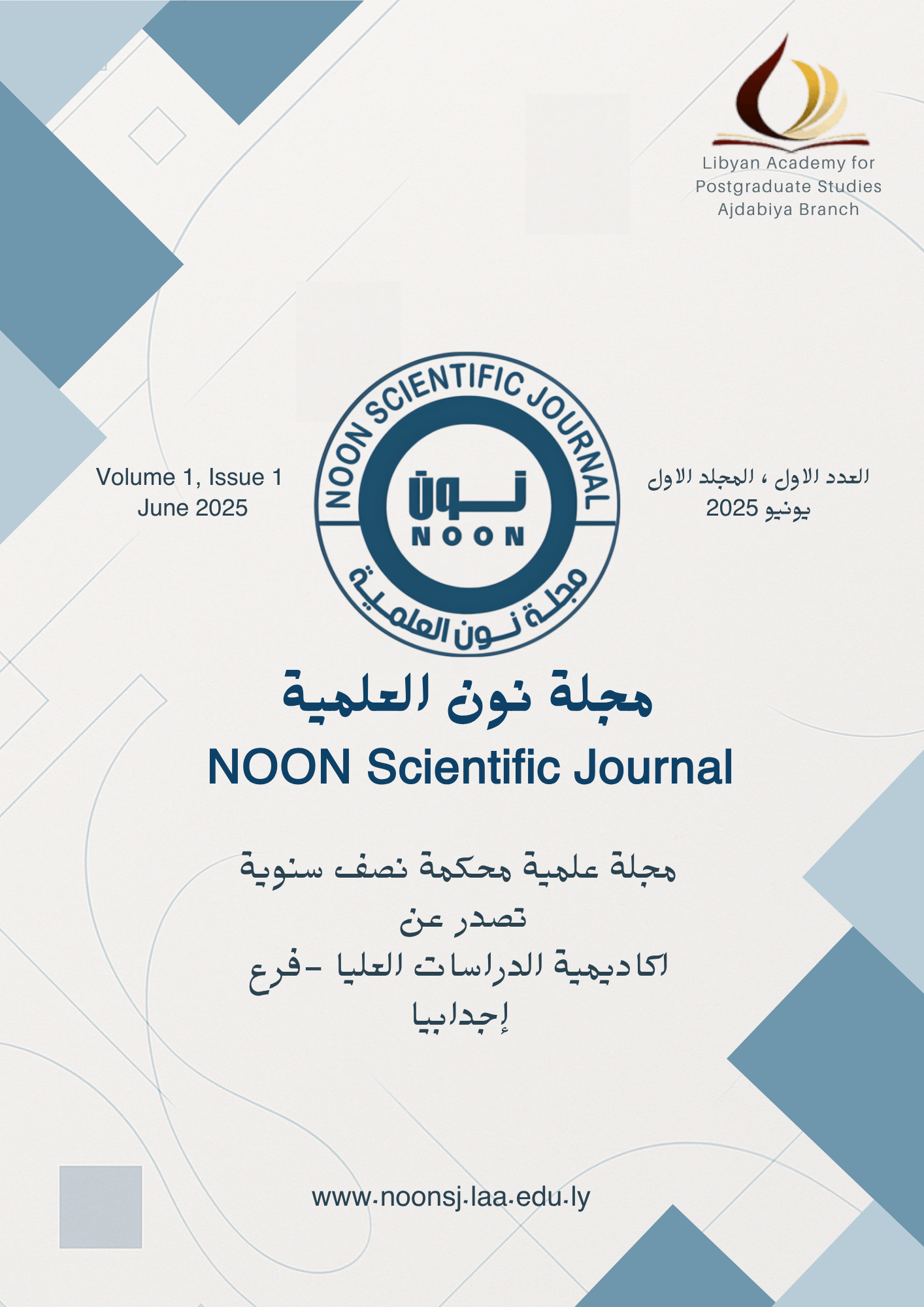Home \ Archives\vol 1, No 1, 2025\ Articles
HYDROGEOCHEMISTRY AND QUALITY OF SURFACE WATER AND GROUNDWATER IN THE WADI BU ASH SHAYKH AND ZALLAH AREAS, SIRTE BASIN, NORTH CENTRAL LIBYA
- OSAMA RAHIL SHALTAMI, ABOBAKAR E. ALGOMATI, KAMAL ABRAHEEM ALMAHDI & FIRAS KHAMIS MUHAMMED
- Benghazi University, University of Bright Star,Omar Al-Mukhtar University, Libya
Volume (1), Issue (1) , June 2025

Published: 06/30/2025
Keywords: Hydrogeochemistry, Drinking Water Quality, Irrigation Water Quality, Sirte Basin,
Libya
Abstract: The present study aimed to perform a geochemical evaluation of surface water and groundwater in the Wadi Bu Ash Shaykh and Zallah areas, Sirte Basin, north central Libya. The chemical data include pH, TDS, TH, K, Ca, Na, Mg, Cl, HCO3, SO4, NO3, F, Li, Sr, B, I, and Br. Based on the Piper diagram, the majority of the water samples are of the NaCl Type. Three types of water are identified by the TDS values: brackish, saline, and hypersaline. The LSI indicate that most samples are saturated with CaCO3. The water samples are unfit for human consumption, as evidenced by the drinking water quality indices (PI and WQI). Moreover, the irrigation parameters (pH, TDS, TH, Na, Cl, HCO3, F, Li, B, Na%, SAR, RSC, MAR, LDP, KR, PI, PS, (Ca+Mg)/(Na+K), and (Ca+Mg)/Na) suggest that the water samples are not appropriate for irrigation.
References
Abu Salem, H. S., El Fallah, O. A., & El Kammar, M. M. (2024). Hydrochemical study of groundwater in Tazerbo, Libya, using statistical analysis and geochemical modeling. Journal of African Earth Sciences, 218, 105362.
Agency for Toxic Substances and Disease Registry (ATSDR). (2004). Strontium: Public health statement (9 p).
Ahwidy, Z. D., & Elsadq, M. E. (2020). Evaluation of some physical characteristics of bottled drinking water samples circulating in Sebha City, Libya. Journal of Pure and Applied Sciences, 19(2), 100–110.
Bajraktari, N., Elshani, A., Shala, A., & Berisha, D. (2022). Determination of water quality for irrigation at the entrance of Radoniqi accumulation with physicochemical and bacteriological parameters for the period of spring 2021. Emirates Journal of Food and Agriculture, 34(9), 750–758.
Boschetti, T., Toscani, L., Shouakar-Stash, O., Iacumin, P., Venturelli, G., Mucchino, C., & Frape, S. K. (2011). Salt waters of the northern Apennine Foredeep Basin (Italy): Origin and evolution. Aquatic Geochemistry, 17, 71–108.
Caerio, S., Costa, M. H., Ramos, T. B., Fernandes, F., Silveira, N., Coimbra, A., & Painho, M. (2005). Assessing heavy metal contamination in Sado Estuary sediment: An index analysis approach. Ecological Indicators, 5, 155–169.
California Plant Health Association. (2002). Western fertilizer handbook (9th ed.). Interstate Publishers.
Carrier Air Conditioning Company. (1965). Handbook of air conditioning system design. McGraw-Hill.
CCME (Canadian Council of Ministers of the Environment). (2001). Canadian water quality guidelines for the protection of aquatic life: Canadian Water Quality Index 1.0 Technical Report. In Canadian environmental quality guidelines (1999). Winnipeg, Canada.
El-Omla, M. M., & Aboulela, H. A. (2012). Environmental and mineralogical studies of the sabkhas soil at Ismailia-Suez roadbed, southern Suez Canal District, Egypt. Open Journal of Geology, 2, 165–181.
Gibbs, R. J. (1970). Mechanisms controlling world water chemistry. Science, 170, 1088–1090.
Halim, M. A., Majumder, R. K., Nessa, S. A., Hiroshiro, Y., Sasaki, K., Saha, B. B., Saepuloh, A., & Jinno, K. (2010). Evaluation of processes controlling the geochemical constituents in deep groundwater in Bangladesh: Spatial variability on arsenic and boron enrichment. Journal of Hazardous Materials, 180(1–3), 50–62.
Health Canada. (2022). Drinking water screening value for iodide – Technical summary. https://www.canada.ca/content/dam/hc-sc/documents/services/publications/healthy-living/drinking-water-screening-value-iodide-technical-summary/drinking-water-screening-value-iodide-technical-summary-en.pdf
Jones, R. J. (1971). Groundwater provinces of Libyan Arab Republic. In Symposium on Geology of Libya (pp. 449–457). Tripoli, Libya.
Jurak, L. (1985). Geological map of Libya, 1:250,000, Sheet: Wadi Bu Ash Shaykh, NH 33-12, explanatory booklet. Industrial Research Centre (IRC), Tripoli, Libya.
Kamboj, S., & Singh, N. (2025). Wintertime water quality assessment via integrated indexical approaches with reference to drinking and irrigation standards in NW India. Environmental Nanotechnology, Monitoring and Management, 23, 101032.
Langelier, W. F. (1936). The analytical control of the anti-corrosion water treatment. Journal of the American Water Association, 28, 1500–1521.
Rowe, D. R., & Abdel-Magid, I. M. (1995). Handbook of wastewater reclamation and reuse. CRC Press.
Sako, A., Semde, S., & Wenmenga, U. (2018). Geochemical evaluation of soil, surface water and groundwater around the Tongon gold mining area, northern Côte d’Ivoire, West Africa. Journal of African Earth Sciences, 145, 297–316.
Shah, B., Kansara, B., Shankar, J., Soni, M., Bhimjiyani, P., Bhanushali, T., Shah, M., & Sircar, A. (2019). Reckoning of water quality for irrigation and drinking purposes in the Konkan geothermal provinces, Maharashtra, India. Groundwater for Sustainable Development, 9, 100247.
Shaltami, O. R., & Algomati, A. E. (2024). Geochemical assessment of bottled water quality in some Libyan factories. Libyan Journal of Engineering Science and Technology, 4(3), 40–46.
Shaltami, O. R., Elmaleky, E. M., El-Fallah, O. A., Fares, F. F., El Oshebi, F. M., Errishi, H., & El Ekhfifi, S. S. (2021). Geochemical evaluation of groundwater: A case study of the Sidi Farag farms, Benghazi City, NE Libya. The Vth International Symposium 2021 (Environmental Quality and Public Health), Budapest, Hungary, 248–256.
Shaltami, O. R., Fares, F. F., Salloum, F. M., Elghazal, R., & El Feituri, M. A. (2017). Assessment of surface water quality for drinking and irrigation purposes in Ain Apollo, Shahat City, NE Libya. 2nd Libyan Conference on Chemistry and Its Applications (LCCA-2), Benghazi, Libya, 127–134.
Sudhakar, A., & Narsimha, A. (2013). Suitability and assessment of groundwater for irrigation purpose: A case study of Kushaiguda area, Ranga Reddy District, Andhra Pradesh, India. Advances in Applied Science Research, 4(6), 75–81.
Tweed, S. O., Weaver, T. R., & Cartwright, I. (2005). Distinguishing groundwater flow paths in different fractured-rock aquifers using groundwater chemistry: Dandenong Ranges, Southeast Australia. Hydrogeology Journal, 13, 771–786.
U.S. Environmental Protection Agency (US EPA). (2023). Lithium in drinking water: A resource for primacy agencies. Technical Fact Sheet (6 p).
Vesely, J. (1985). Geological map of Libya, 1:250,000, Sheet: Zallah, NH 33-16, explanatory booklet. Industrial Research Centre (IRC), Tripoli, Libya.
World Health Organization (WHO). (1997). Guidelines for drinking-water quality: Recommendations (Vol. 1, 2nd ed.). WHO, Geneva.
World Health Organization (WHO). (2004). Fluoride in drinking-water: Background document for development of WHO guidelines for drinking-water quality (9 p).
World Health Organization (WHO). (2009a). Boron in drinking-water: Background document for development of WHO guidelines for drinking-water quality (28 p).
World Health Organization (WHO). (2009b). Bromide in drinking-water: Background document for development of WHO guidelines for drinking-water quality (15 p).
World Health Organization (WHO). (2011). Hardness in drinking-water: Background document for development of WHO guidelines for drinking-water quality (11 p).
World Health Organization (WHO). (2017). Guidelines for drinking-water quality: First addendum to the 4th edition (137 p). WHO, Geneva.
Yousef, A. F., Saleem, A. A., Baraka, A. M., & Aglan, O. Sh. (2009). The impact of geological setting on the groundwater occurrences in some wadies in Shalatein–Abu Ramad area, SE Desert, Egypt. European Water, 25/26, 53–68.
Zaidi, F. K., Mogren, S., Mukhopadhyay, M., & Ibrahim, E. (2016). Evaluation of groundwater chemistry and its impact on drinking and irrigation water quality in the eastern part of the Central Arabian graben and trough system, Saudi Arabia. Journal of African Earth Sciences, 120, 208–219.
